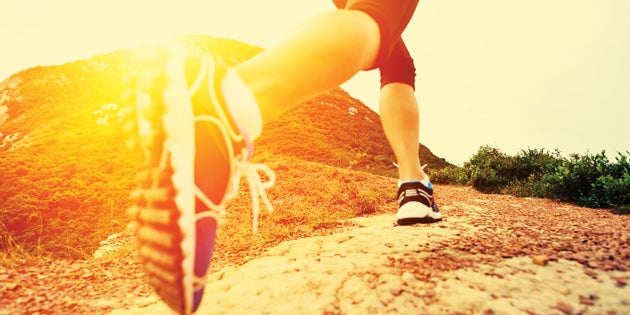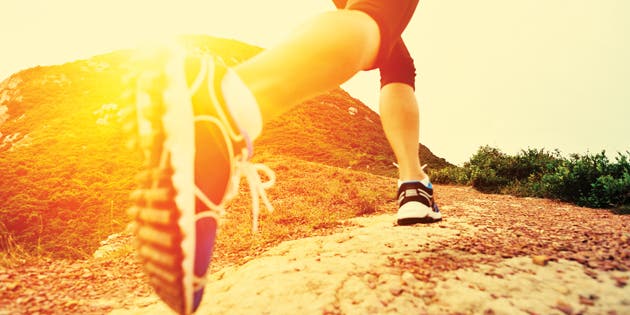Fresh Air Fitness


Spring has sprung and you’re probably itching to get outside. What better way to enjoy the new green of nature and stretch your winter-weary muscles than with trail running.
A “trail” is anything off-road or unpaved, such as a singletrack through the mountains, a gravel path or wide dirt road. Some trails are steep and technical, while others are wide and meandering. There is literally a path for everyone to take, and this wide variety of terrain makes trail running the perfect activity for people of all levels and abilities. In addition, soft surfaces such as dirt, bark and grass are more forgiving than pavement and concrete, meaning less jarring of your joints and a decreased likelihood of injury.
Even regular runners can benefit from switching things up from time to time. “Trail surfaces are different than roads and require adaptation and specific training to excel,” says Nancy Hobbs, founder and executive director of the American Trail Running Association and co-author of The Ultimate Guide to Trail Running (Falcon Guides/Globe Pequot Press 2010). “Many runners choose to think in terms of time on the trails versus distance since the terrain and elevation can affect the amount of time it takes to run a distance you could normally do quickly. Some trail runners even prefer to think in terms of vertical gain, especially if they are focused on uphill/ascending routes.”
In addition, you move and think differently when running a trail versus the flat. “Side-to-side movements and avoiding obstacles utilize your muscles differently than road running,” says Amanda McIntosh, endurance coach, professional ultramarathoner and two-time Leadville 100 champion. Whereas you may have a tendency to zone out on a treadmill in the gym, you need to be present and in the moment when trail running so as not to bite the dust — literally. “Look down at the trail and glance several meters ahead from time to time to see obstacles that are coming up,” McIntosh recommends. “At first, this will be a tedious process, but as you get used to trail running, it will become natural and easy.”
The Ups and Downs of Trail Running Like a Pro
If you’re new to trail running, start on a nontechnical trail to get your bearings. “A good idea is to start out hiking and work up to running at various intervals during the hike,” Hobbs says. “Planning foot plants one to three strides out is suggested, which requires having your eyes focused on the trail underfoot.”
Once you get the hang of it, run until it’s difficult, then walk until it’s easy, McIntosh says. “I walk uphill in both training and racing if I need to,” she says. “It’s perfectly acceptable to do if you’re tired, so long as you keep good form.”
Speaking of form, here are the experts’ pointers and tips to make the most of your run while keeping joints safe and healthy.
Uphill

• Take shorter, quicker strides, and lift your knees higher to move up the hill effectively.
• Use your arms to generate power and momentum.
• Keep your weight over your feet so you can react quickly and keep your balance as you navigate the trail.
• Lean into the hill about 10 degrees without hunching, keeping your abs tight and your focus forward.
• Step on your midfoot and roll through your toes as opposed to running on your tiptoes and burning out your calves.
• Allow your arms to flare out to the sides to help you maintain balance and allow for agility.
• Uphill runners should yield to downhill runners.
Downhill
• Don’t slam on the brakes with each step; land on your midfoot instead of your heel to absorb the impact.
• Land with your knees slightly bent to prevent jarring and shearing forces.
• Battle your inclination to lean backward and instead lean forward from the ankles and let the hill pull you down.
• Your upper body should be perpendicular to the ground if not slightly ahead of your lower body.
• If the hill is super steep, use a slalom technique in which you leap gently side to side to maintain speed while preventing a fall.
• Focus ahead of you — not on your feet — to keep yourself upright and balanced.
• Imagine you’re running on hot coals and keep your ground contacts quick and light.
Safety First
Nothing is more important than being safe and properly outfitted in the wilderness. Use these tips to ready yourself for the challenge:
• Map your course ahead of time and share your plans to someone who is not going with you, especially if the trail is remote or lengthy. (Hello — did anyone see 127 Hours?)
• Use sunscreen, even if you think you’re going to mostly be in the woods. UV rays can still filter through the leaves and give you a nasty burn.
• If you’re running in deep woods, use good bug spray to ward off mosquitoes, ticks and horseflies.
• Be aware of your surroundings and watch out for roots, rocks, water, slippery leaves and even wildlife!
• Purchase shoes specific to trail running, which have a lower profile for better balance, deeper treads for better traction and good drainage if you have to traverse water obstacles. (See “Sole Mates” for suggestions.)
• Use a hydration pack with multiple pockets to carry water, gel and fuel for your run, as well as extra clothing layers such as a jacket and hat if it gets cold and extra socks in case yours are wet or torn.
• Skip the headphones. You need to be able to hear other people or any animals in your vicinity.
• Consider the following optional gear: headlamp in case it gets dark, gloves for protection against rocks or in case of falls, and gaiters to keep scree and rocks from getting into your shoes.
• Pack out anything you take in. The wilderness should stay wild and free — free from litter or other no-nos. Be respectful of Mother Nature: Leave only footprints, take nothing but memories.
Trail Mix
Proper nutrition is essential when trail running, especially if you’re planning a long trip. Here are some suggestions from endurance coach Amanda McIntosh to keep you energized for the duration:
Two to three hours beforehand: Eat a combination of carbs and protein such as an egg and toast, and drink plenty of water.
During your run: Consume one gel pack and 16 to 20 ounces of water for every 45 to 60 minutes of running.
Immediately post-run: Use a recovery drink or a shake to replenish lost glycogen and begin the repair process.
One hour post-run: Eat a solid meal that has carbs, protein, veggies and a healthy fat.
3 Moves to Get You Going
The trails can be tricky — prepare yourself for their rigors by adding these three moves to your workout program. Do three sets of 12 to 15 reps apiece, and use a moderately heavy weight for all three.
Overhead Squat

Squatting with a weight overhead forces your core to work twice as hard while training the quads, glutes and hamstrings to be powerful.
Setup: Hold a medicine ball overhead with your arms straight and stand with your feet hip-width or slightly wider apart.
Move: Kick your hips back and bend your knees to squat down, keeping your arms straight with the plate/ball directly overhead and your weight in your heels. When your hip crease comes below your knee, drive through your heels to reverse the move and return to standing.
Single-Legged Calf Raise

Your calves and ankles need to be strong and flexible; this move trains them for both.
Setup: Stand with one heel hanging off the edge of a step or plate and your other leg lifted behind you, knee bent. Allow your heel to sink low, getting a good stretch in your calf.
Move: Slowly rise up through the ball of your foot and onto your toes, pausing a moment at the peak before returning slowly to the start. Do all reps on one side before switching.
Russian Twist

Balance and agility originate in the core, and this move hones those muscles.
Setup: Sit on the floor with your knees bent and hold a medicine ball or plate at your chest. Balance on your tailbone and lean back slightly with a straight back and lift your feet off the floor, knees together.
Move: Moving your torso and arms as one unit, twist side to side and touch the ball down to the floor by your hip. Maintain an even pace and remember to breathe.